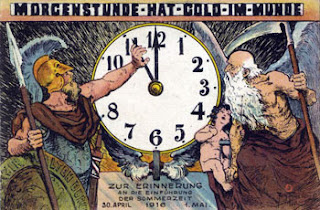General Dwight David Eisenhower is one of the most infamous faces of the Second World War, in addition to his legendary status in American history as a whole. A lifelong military career led to his role as commander of Operation Torch (Allied landings in Algeria and Morocco) in 1942, supreme commander of the Allied Expeditionary Force in 1943 during which he forged the path to Allied victory with the D-Day landings, and eventually the thirty-fourth President of the United Sates. However, there is an aspect of Ike's personal life that has been the subject of markedly less flattering discussion. It's a story right out of a "historical" drama film, and grade twelve me was absolutely captivated by it: Did Ike have an affair with his gorgeous ex-model assistant, Kay Summersby?

Ike and Mamie in 1915 (Left) and in 1916 (Right)
Dwight David Eisenhower was born in 1890 in Texas and was brought up in Abilene, Kansas. He attended the prestigious West Point military academy, and it was during his first posting to Texas that he met Mamie Geneva Doud. The two were married in 1916 and went on to have two sons, one of whom died in infancy.
 |
| Summersby attaching a pennant to Ike's Cadillac |
Kay Summersby had been a model before war broke out with Worth, the Paris house of haute couture, and subsequently joined the British Motor Transport Corps (MTC). This was a volunteer unit whose original members were bright, attractive British post-debutantes who had driven ambulances during the Blitz in East London. Summersby started working for Ike in London in May 1942, during which time they became close friends.
Unfortunately for Mamie, she was not permitted to be with Ike while he was overseas. His London residence during the war consisted of three large rooms at a first-class hotel, The Dorchester. During his entire time away, Ike wrote Mamie a total of 319 letters, to which she responded just as frequently. Interestingly, Mamie kept the letters she received from her husband, while he did not keep hers. Shortly after his arrival at The Dorchester, Ike wrote her:
"I cannot tell you how much I miss you... An assignment like this is not the same as an absence from home on maneuvers. In a tent, surrounded by soldiers; it seems natural to have to get along alone. But when living in an apartment, under city conditions, I constantly find myself wondering, 'why isn't Mamie here?' You've certainly become most necessary to me."
Kay Summersby, however, was much more available. Ike had to put in some effort to locate her and secure her as his permanent driver, and he ended up having to steal her from another general. When he began planning for Operation Torch, he was given a retreat in the English countryside called Telegraph Cottage. It was there that he spent many nights a week playing bridge with Kay against his aides.
With a sort of family being established, Ike asked Kay if she would like to have a dog. Since he had never had one before during his military career, he let her narrow down some options and he finally chose a Scottie, naming it "Telek" and saying that its origins were "a military secret". He told Kay that "It's a combination of Telegraph Cottage and Kay, two parts of my life that make me very happy." He did write Mamie about the dog, saying "You can't talk war to a dog, and I'd like to have someone or something to talk to... A dog is my only hope."
Kay got to accompany Ike on an inspection trip to Scotland, and he even invited her to come to North Africa with him, though she had to wait about a month. This trip would be an assignment far removed from her role with the MTC. In order to keep his departure top-secret, a cover story was devised that he was returning to Washington, and Mamie prepared to receive her husband at their apartment. Due to security, there was no way he could tell her that he was not actually coming, and he even had to write her forty-sixth birthday letter in advance:
"I'd like to be there to help you celebrate, and to kiss you 46 times (multiplied by any number you care to pick). I will be thinking with the deepest gratitude of the many happy hours and years you have given me... I've never wanted any other wife-- you're mine, and for that reason I've been luckier than any other man."
Kay finally joined him in Algiers with other female assistants after a harrowing journey on a troopship that was sunk by a German submarine. Major-general Everet Hughes, Ike's right hand man, recorded in his diary following the grand reunion and Christmas party: "Sat around with Ike after the party broke up. Discussed Kay. I don't know whether Ike is alibiing or not. Says he likes her. Wants to hold her hand. Doesn't sleep with her. He doth protest too much..." That very same day, Ike penned a passionate love letter back home to Mamie. By New Year's, he was attempting to reconcile love for Mamie with his growing feelings for Kay, and wrote home again:
"...I've never been in love with anyone but you! I never will."
 |
| The cover of LIfe containing the scandalous article |
Ike and Kay enjoyed many more private times during retreats in North Africa. On 22 February, 1943, an article published in Life magazine called "Women in Lifeboats" featured "the irrepressible Kay Summersby, Eisenhower's pretty Irish driver" and included two photos of her. Mamie saw the article and was hurt and embarrassed, but a desperate letter of explanation from Ike squashed these feelings. However, Kay soon became his personal assistant, and the two began spending more time together than ever. Ike and Mamie had not seen each other by that point in almost a year.
The relationship between Kay and Eisenhower continued to become more passionate during his intense planning of the D-Day landings, and by January 1944 she was wearing uniforms made by Ike's own personal tailor. On the eve of D-Day in June, he chose to spend the dreadfully anxious period waiting for reports alone in a trailer with Kay.
After the successful landings and downfall of the war, Ike was regarded as an all-American hero. Heroes, however, don't have mistresses, and he was forbidden to take Kay back to the USA with him in 1945. After having traveled with him throughout the war, Telek remained with Kay and died in 1959 at the age of 17. Ike and Kay never spoke intimately again; he returning to life with Mamie and Kay to eventually marry. In 1974, she wrote of her wartime affair with America's great general based on his wartime diaries and died shortly after.
Information for this post comes from Dan Parry's D-Day: Reflections of Courage (2004) and Jean Edward Smith's Eisenhower: In War and Peace (2012), which is a highly recommended read for those interested in Ike.
What do you think? Was Ike just a lonely man looking for companionship during the most trying times imaginable? Does this affect how we think of him today? How do you feel about Kay Summersby? Let me know!
Thanks for reading,
Delany











































